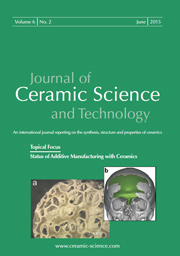Articles
All articles | Recent articles
Phase Evaluation of YSZ upon Doping with Ta5+, Ti4+ and Ca2+ with Combined Raman and XRD Analysis
A. Bhattacharya1, T. Wermelinger2, V. Shklover1
1 Laboratory of Crystallography, Department of Materials, ETH Zürich, 8093 Zürich, Switzerland
2 Institute of Nanometallurgy, Department of Materials, ETH Zurich, 8093 Zurich, Switzerland
received August 20, 2012, received in revised form November 1, 2012, accepted November 7, 2012
Vol. 3, No. 4, Pages 211-214 DOI: 10.4416/JCST2012-00028
Abstract
To improve the phase stability of 7YSZ (7 wt%-Y2O3-doped ZrO2), it has been doped with larger (Ca2+) and smaller (Ti4+ or Ta5+) ions. Complementary Raman and XRD studies of these stabilized systems have been performed. The tetragonal symmetry of the Ta5+-ion-doped YSZ sample and the Ti4+-doped YSZ sample, and the cubic symmetry of Ca2+-doped YSZ have been confirmed both by means of XRD and Raman analyses. Raman scattering measurements show shifts of characteristic peaks when the YSZ is doped with Ta5+, Ti4+ and Ca2+ cations. The peak shift increased with increasing dopant concentration in the ZrO2 lattice. The Ta-doped YSZ sample heat-treated below 1500 °C contained some YTaO4 phase, which was confirmed by means of XRD as well as by Raman spectroscopy. The effect of Ca2+ ion doping on the Raman peak shift was much higher than that of Y3+ ion doping. In this work it has been highlighted that Raman spectroscopy is a useful tool complementing XRD, for qualitative comparison of the doping effect on the lattice parameters of ZrO2.
![]() Download Full Article (PDF)
Download Full Article (PDF)
Keywords
TBC, YSZ, Raman spectroscopy, XRD, ZrO2
References
1 Levi, C.G.: Emerging materials and processes for thermal barrier coatings, Curr. Opin. Solid St.M., 8, 77 – 91, (2004).
2 Jones, R.L., Mess, D.: Improved tetragonal phase stability at 1400 °C with Scandia, yttria-stabilized zirconia, Surf. Coat. Tech., 86 – 87, 94 – 101 (1996).
3 Miller, R.A., Smialek, J.L., Garlick, R.G.: Science and technology of zirconia, Am. Ceram. Soc., Inc., Columbus, OH, 241, (1981).
4 Cainery, J.M., Rebollo, N.R., Ruehle, M., Levi, C.G.: Phase stability of thermal barrier Oxides: a comparative study of Y and yb additions, Int. J. Mat. Res., 98, 12, 1177 – 1187, (2007).
5 Schaedler, T.A., Leckie, R.M., Kraemer, S., Evans, A.G., Levi, C.G.: Toughening of non-transformable t′-YSZ by addition of titania, J. Am. Ceram. Soc., 90, 3896 – 3901, (2007).
6 Kim, D.J., Tien, T.Y.: Phase stability and physical properties of cubic and tetragonal ZrO2 in the system ZrO2-Y2O3-Ta2O5, J. Am. Ceram. Soc., 74, 3061 – 3065, (1991).
7 Pitek, F.M., Levi, C.G.: Opportunities for TBCs in the ZrO2-YO1.5-TaO2.5 system, Surf. Coat. Technol., 201, 6044 – 6050, (2007).
8 Keramidas, V.G., White, W.B.: Raman scattering study of the crystallization and phase transformations of ZrO2, J. Am. Ceram. Soc., 57, [1], 22 – 24, (1974).
9 Yashima, M., Ohtake, K., Kakihana, M., Arashi, H., Yoshimura, M.: Determination of tetragonal-cubic phase boundary of Zr1-xRxO2-x/2 (R= nd, sm, Y, er and Yb) by raman scattering, J. Phys. Chem. Solids, 57, [1], 17 – 24, (1996).
10 Kim, D.J., Jung, H.J., Yang, I.S.: Raman spectroscopy of tetragonal zirconia solid solutions, J. Am. Ceram. Soc., 76, [8], 2106 – 2108, (1993).
11 Michel, D., Van Den Borre, M.T., Ennaciri, A.: Vibrational spectra and force fields of tetragonal zirconia and zirconium germinates, p. 555 – 62 in Advances in Ceramics, Vol. 24, Science and Technology of Zirconia III, edited by S. Somiya, N. Yamamoto and H. Yanagida. American Ceramic Society, Westerville, OH, (1988).
12 Thackery, D.P.S.: The raman spectrum of zirconium dioxide, Spectrochim. Acta A, 30, 549 – 550, (1974).
13 Garvie, R.C., Nicholson, P.S.: Phase analysis in zirconia systems, J. Am. Ceram. Soc., 55, [6], 303 – 305, (1972).
Copyright
Göller Verlag GmbH


